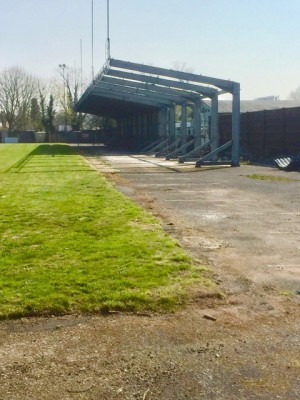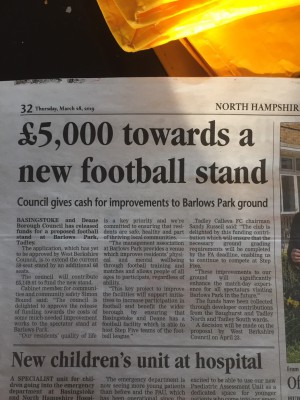How to object to WBC’s MUGA fence & lights at Faraday Road, either online:
or by email to:
planapps@westberks.gov.uk quoting reference 19/00814/FUL
(you can copy and paste the text below or make your own version)
For the following reasons, I strongly object to the
proposed development of 4 x multi-use games areas with replacement gates and
new fencing; 8 x new floodlights (replacing existing 6 x floodlights) at
Newbury Football Club, Faraday Road Newbury Berkshire RG14 2AD:
1. As a technical point, the address
is incorrect. The correct address is Newbury Football Ground, not Newbury
Football Club. The Council persistently misnames Newbury’s football
ground and by doing so leads the public to believe that use of the Ground is
(was) reserved for a private club. This is emphatically not the case, the
Ground is a public facility and, until closed by the Council without
consultation or supporting evidence) widely used by the footballing community
of Newbury.
2. The application affects a
registered Asset of Community Value, which given the circumstances (very strong
local support and evidence of need combined with protection under local and
national planning policy), the LPA should conclude is a material consideration
(para 2.20 of the DCLG advice). The assessment of materiality must be
reasonable and rational, taking into full account all of the circumstances:
a.
R (oao Loader) v Rother DC [2015] EWHC 1877 (Admin): “at present
there is no direct case law on what weight is attached to ACV listing. The
weight to be given to any material consideration is a matter for the
decision-maker, subject to his decision being reasonable and rational in all
the circumstances.”
b.
Banner Homes v St. Albans City Council [2016] UKUT 0232 (ACC) at para.
4, Upper Tribunal Judge Leverson “as a matter of planning policy any
necessary permission is likely to be refused while land is listed.”
There is no evidence to support the
application. By contrast, the ACV status and information submitted in
support of conjoined planning applications 18/00603/COMIND and 18/00064/OUT
(for a new fully equipped community football facility) provides strong evidence
that the Ground fulfils a very important function for the community as a
facility for organised football on full-size pitches and other amenities (as
described below).
3. The application fails to
consider the Council’s emerging playing pitch strategy, which (according to
evidence by Sport England and the FA) should conclude that the Ground as
currently configured (i.e. including a full-size pitch, stand, lighting,
clubhouse, changing facilities and fencing) is needed as a facility for
organised football.
4. The absence of changing
facilities will severely limit the practical use of the facility.
5. The reconfiguration of the
facility into MUGA is squarely at odds with the evidentially supported need for
a complete facility for organised football (as described above)
6. The application fails to
consider either the NPPF or Sport England’s planning policies for playing
pitches. It is therefore incomplete and invalid.
7. The application is to replace
an existing facility. Paragraph 97 of the NPPF applies:
Existing open space, sports and recreational
buildings and land, including playing fields, should not be built on unless:
…..(c) the development is for alternative sports and recreational provision,
the benefits of which clearly outweigh the loss of the current or former use.
The application fails to include evidence to
satisfy this obligation. By contrast, NCFG has supplied extensive
evidence that the existing protected use for organised football is in very wide
demand and urgently required.
8. The application fails to
accord with the West Berkshire Core Strategy, particularly:
Area Delivery plan Policy 2: Existing community facilities
will be protected and, where appropriate, enhanced. These include leisure and
cultural facilities, which contribute to the attraction of the town for both
residents and visitors. Newbury Football
Ground is classified on West Berkshire Council’s Online Map as a Cultural
facility for Football.
CS18: Developments resulting in the loss
of green infrastructure or harm to its use or enjoyment by the public will not
be permitted. Supporting text paragraph 5,124 defines Green Infrastructure
as Outdoor sports facilities and 5.129 names Newbury Football Ground (referred
to as “Newbury Town”) as one such protected facility.
9. The application fails to make
provision for a replacement facility, as required by Paragraph 97 of the NPPF
and CS18:
NPPF: Existing open space, sports and
recreational buildings and land, including playing fields, should not be built
on unless: …..(b) the loss resulting from the proposed development would be
replaced by equivalent or better provision in terms of quantity and quality in
a suitable location;
CS18: Where exceptionally it is agreed that an
area of green infrastructure can be lost a new one of equal or greater size and
standard will be required to be provided in an accessible location close by
10. Sport England’s planning
policies make similar demands that have not been met by the application, as is
confirmed by Sport England’s standing objection.
11. In land use planning terms,
the application is a change of use from a protected use. The application,
which does not include details of the playing surfaces (or other details) is
therefore inadequate and incomplete.
12. Section 14 of the application
form states that the Existing Use as a “Vacated sports venue, not currently in
use” and as a “Former sports venue for Newbury Football Club”. The former
statement is disingenuous and the latter is a falsification:
a.
The Ground was made vacant only because the Council has locked up the
facility and prevented public use. But for its actions the Ground would
still be in use by the public as a football facility. The vacancy is
therefore a contrivance by the Council, which obviously breaches the principles
of planning land use.
b.
The former use (which would be the current use but for the actions of
the Council) was as a public facility for organised football. The Council
is aware of this, not least because its lease to Newbury Football Club included
an obligation for said club to make the facility available for public
use. Irrefutable evidence of extensive use by the public has been supplied
to the Council and is available on http://www.ncfg.uk/ .
13. The application is registered
as a minor application. An examination of the location plan reveals that the
site are is almost 1 hectare. The location plan excludes parts of the existing
ground and buildings that are certainly be affected by the proposed development
(e.g. demolition of the club house, etc.). Any development of land of
more than 1ha is a major application. The Council might be trying to rely
on permitted rights to demolish the buildings etc., but that would be a
contrivance that is clearly designed to reduce the site area. The stated
site area of under 1ha is a misrepresentation and the application is
therefore invalid.
14. The implementation of a
permission for the application would put the Council at a financial
disadvantage. This is a material planning consideration.
15. Whilst not necessarily a
planning consideration, the application breaches the Council’s Consultation
Policy, including (but not limited to Chapter 1: West Berkshire Council
(WBC) is committed to making sure decisions are evidence-based, taking into
account the views and experiences of residents and service users. As a
matter of fact, no consultation has taken place.
16. Equally, the Council has stated
publically that the site will be redeveloped into flats in the near term.
Notwithstanding that such a claim would appear to be a pre-determination of a
future planning application, it must follow that the application for MUGAs and
associated infrastructure is for a temporary use. The application
does not make this clear.





